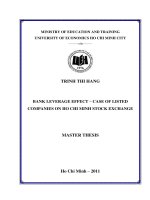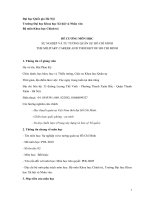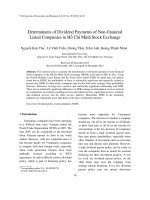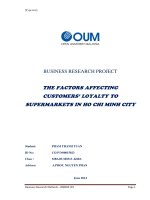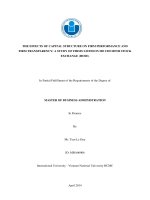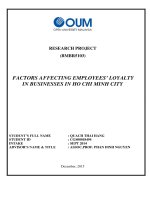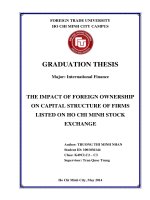Behavioral factors affecting herding bias the case of ho chi minh stock exchange, vietnam
Bạn đang xem bản rút gọn của tài liệu. Xem và tải ngay bản đầy đủ của tài liệu tại đây (1.97 MB, 77 trang )
UNIVERSITY OF ECONOMICS HO CHI MINH CITY
International School of Business
--------
Doan Thi Mai Phuong
BEHAVIORAL FACTORS AFFECTING
HERDING BIAS: THE CASE OF HO CHI MINH
STOCK EXCHANGE, VIETNAM
SUPERVISOR: Prof. Nguyen Dong Phong
Dr. Nguyen Phong Nguyen
HO CHI MINH CITY - 2015
1
TABLE OF CONTENTS
CHAPTER 1: INTRODUCTION ..................................................................................................................... 2
1.1.
Background......................................................................................................................................... 2
1.2.
Problem statement .......................................................................................................................... 4
1.3.
Research question ........................................................................................................................... 6
1.4.
Research scope.................................................................................................................................. 7
1.5.
Research methods ........................................................................................................................... 7
1.6.
Significance of the research ........................................................................................................ 8
1.7.
Structure of the study .................................................................................................................... 8
CHAPTER 2: LITERATURE REVIEW ...................................................................................................... 10
2.1.
Theorical background ................................................................................................................. 10
2.2.
Review on some behavioral factors and herding bias in stock market ................ 12
2.2.1. Risk tolerance ......................................................................................................................... 12
2.2.2. Over-confidence .................................................................................................................... 13
2.2.3. Self-monitoring ...................................................................................................................... 15
2.2.4. Gambler’s fallacy ................................................................................................................... 16
2.2.5. Illusion of control bias ........................................................................................................ 16
2.2.6. Herding bias ............................................................................................................................ 17
2.3.
Hypothesis development ........................................................................................................... 20
CHAPTER 3: RESEARCH METHODOLOGY .......................................................................................... 25
3.1. Measurement scales ........................................................................................................................ 25
3.1.1. Scales measurement of Risk Tolerance .......................................................................... 25
3.1.2. Scales measurement of Over-confidence ....................................................................... 25
3.1.3. Scale measurement of Self-monitoring ........................................................................... 26
3.1.4. Scale measurement of Gambler’s Fallacy ....................................................................... 27
3.1.5. Scale measurement of Illusion of control....................................................................... 28
3.1.6. Herding bias ................................................................................................................................ 28
3.2. Sampling ............................................................................................................................................... 29
3.3. Data collection methods ................................................................................................................ 29
3.4. Data analysis methods .................................................................................................................... 30
3.4.1. Test of scale measurement reliability.............................................................................. 30
3.4.2. Exploration factor analysis (EFA) ..................................................................................... 31
CHAPTER 4: DATA ANALYSIS AND FINDINGS ................................................................................. 33
4.1. Descriptive statistics: ...................................................................................................................... 33
4.2. Refinement of measurement scales.......................................................................................... 34
4.2.1. Result of Cronbach’s alpha analysis of formal survey (N=205) ........................... 34
4.2.2. Factor analysis (EFA) .............................................................................................................. 35
4.3. Testing the assumptions of regression ................................................................................... 39
4.4. Results of hypothesis testing ....................................................................................................... 40
4.4.1. Regression model ..................................................................................................................... 40
4.5. Chapter summary ............................................................................................................................. 43
CHAPTER 5: CONCLUSIONS AND IMPLICATIONS .......................................................................... 44
5.1. Main Findings ..................................................................................................................................... 44
5.2. Managerial Implications ................................................................................................................ 45
5.3. Limitations ........................................................................................................................................... 47
REFERENCES ................................................................................................................................................... 48
APPENDICES .................................................................................................................................................... 57
ABSTRACT
The stock market is more and more unpredictable which traditional finance
theories cannot give reasonable explanation.Behavioral finance, instead, can be
helpful in the current situation of the fluctuating market. Herding activities among
investors have been a popular behavioral explanation for the excess volatility and
short term trends observed in financial market. However, the number of research
focusing on herding and its impacts on the financial market, especially Vietnamese
stock market, is limited.This research will identifythe behavioral factors affecting
the herding bias existing at the HOSE since it was established (2000) and the impact
levels of behavioral elements on the herding bias.
Using a data set form a sample of more than 200 investors, we find that investors’
decisions much depends on their own emotion rather than fundermental analysis
and technical analysis. Moreover, investors generally prefer short-term portfolios
(T+3) to long-term ones.
In addition,due to the limited level of security understanding, investors usually
consider the stock market as a “casino” where luck is the most vital element to win.
On the other hand, investorswho are too confident about their investment decision
usually make mistakes in their short-term investment.
Keywords: Herding behavior, behavioral finance.
1
CHAPTER 1: INTRODUCTION
1.1.
Background
Vietnamese stock market was formed in 1998 including Ho Chi Minh City
Stock Exchange (HOSE) and Hanoi Stock Exchange (HNX). At the very first
stage, the Vietnamese stock market was launched on 28 July 2000 with
merely 2 listed companies along with 4 security companies and the growth of
the number of listed companies was quite slow. Having passed so many upsand-downs, there are currently 181 security-company members1after
approximately 14 years. However, in comparison to other developed and
emerging markets, Vietnamese stock market appears to be much smaller in
terms of scale and maturity. Although the Ho Chi Minh City stock exchange
(HOSE) has witnessed considerable developments both in the number of
listed stocks and in transaction value for 14 years, the price movement seems
to fluctuate unpredictably over different periods. Starting at 100 points in
July 2000, after 1 year, at June 2001, the VN-Index was fivefold and reached
the peak at 571 points. Investors were too excited and dreamed of earning
money quickly that the demand rose significantly while there were only few
listed stocks in the market (Huy, 2010). However, it was the lack of
knowledge and trading experience of investors as well as the insufficient
support from the authorities which made VN-Index suddenly unceasingly fall
until it reached the bottom at 139 points in March 2003 (Huy, 2010).
Investors who joined the market in this period and could not jump out
quickly had to face the financial difficulties because of the huge loss of assets.
The stock market then seemed to fall in its hibernation status until 2005 and
eventually woke up in 2006. The boom started in the second half of 2006 and
1According
to the latest available data as at 20 May 2014 on the websites of Ho Chi Minh City and Ha Noi
stock markets
2
rocketed up to 1,170 points by March 2007. This fluctuated around 1,000
points until October 2007. The Ho Chi Minh City stock market had never been
“hotter” than that time. Nevertheless, VN-Index went to its decline stage after
being pushed up to the peak. Ho Chi Minh City stock market experienced a
gloomy year in 2008 and VN-Index merely stopped falling in February 2009
at 235 points (Huy, 2010). The possible explanations for the sharp dip of the
VN-Index were the impacts of numerous factors, namely, tightening of
monetary policies, especially lending for stock investment, high deposit
interest rates, high inflation rate, and a recession of the United State
economy. Moreover, lack of timely intervention by the authorities was also a
breeding ground of the dramatically decrease of VN-Index (Vo and Pham,
2008). From 2009 to the first quarter of 2011, VN-Index continued to
undergo many ups-and-downs, reached another peak at 542 points in May
2010 and another bottom at 351 points in November 2011. Nonetheless, it
seemed to fluctuate between 400 and 500 points with no significant
amplitude found in 2012 and finally stood at 505 points on December 31st
2013, increasing by 23% compared to 2012 (Luyen, 2013).According to
Phu(2010), one of the most important factor resulting in the fluctuation of
stock prices is the herding bias. Specifically, when the price of stock increases,
a huge number of investors begin buying with the hope that the price will
continue to rise. However, the price only goes up to a specific point and after
that will go down. When the price decreases, be afraid that the price decline
unceasingly, almost investors will sell with high selling pressure. In the other
words, investors seem to takes action followed their psychology and emotion
rather than rational mind which does not make the market complied with
supply-demand rule and may lead to the collapse of the market. To explain
these fluctuations during the period, I assume that herding bias may be the
most important factor leading to this phenomenon in the case of Vietnamese
stock markets; therefore, it should be analyze in depth.
3
Regarding the theoretical background on behavioral factors and herding bias,
if Expected Utility Theory (EUT) may be deemed by a fundamental theory of
traditional finance, prospect theory is the basic theory of the behavioral
finance. Prospect theory concentrates on subjective decision-making affected
by the investors’ value system, while EUT focuses on investors’ rational
expectations (Filbeck, Hatfield & Horvath, 2005). EUT is the normative model
of rational choices and descriptive model of economic behaviors, which
dominate the analysis of decision making under risk. However, this theory is
criticized for failing to explain why people are appealed to both insurance and
gambling. People tend to under-weigh probable outcomes compared to
certain ones and they differently response to the similar situation depending
on the context of losses and gains in which they are presented (Kahneman &
Tversky, 1979). Prospect theory describes some states of mine affecting an
individual’s decision making process including Regret aversion, Loss aversion
and Mental accounting (Waweru et al, 2003, p.28).
Based on the background, the problem statement would state my concern
about the impact of behavioral factors on herding bias in the case of
Vietnamese stock market.
1.2.
Problem statement
Only recently established in 2000, the Vietnamese stock market is
characterized by weak reporting requirements, poor regulations and low
accounting standards (Tran and Truong, 2011). During the formulation and
development process, the Vietnamese stock exchange in general and the
HOSE in particular went through many different stages. Specifically, its prices
fluctuate unpredictably and it seems difficult for investors to make rational
decisions. Despite the dramatic fluctuations of price through the period as
well as the instability of the market, there have been few studies of the
Vietnamese stock exchange, particularly dealing with herding issues.
4
Although a variety of commentaries based on the conventional financial
theories have been proposed, they failed to explain what happened at the
HOSE over the past period. Alternatively, behavioral finance can be helpful in
the case of the HOSE since it is based on the psychology to explain why people
buy or sell stocks (Waweru et al., 2008). Behavioral factors include
overconfidence, representativeness, availability, loss aversion, regret
aversion, gamble’s fallacy, over-under reaction, herding and so on (Ritter,
2003). Herding activities among investors have been a popular behavioral
explanation for the excess volatility and short term trends observed in
financial market (Juan Yao et al., 2014). Moreover, many studies carried out
in Vietnamese stock market such as Farber et al (2006), and Tran
(2007)identified that herding effect in this market is very strong, especially
toward positive return of the market. Specifically, Farber et al (2006)
conducted a study aboutthe impact of policy on Vietnam stock market and
found out the empirical evidence for the well-known herding behavior among
investors, by which people suppressed own private information and
expectations to follow the market’s collective action. They also stated that
“the trend of herding behavior is stronger toward extreme positive returns of
the market, and in fact, around the consecutive sequence of limit-hits”
(Farber et al, 2006, p.25).
Besides, Chen et al (2003) argued that herding was more likely to happen in
emerging markets than developed ones as the government intervention was
high, and the quality of information disclosure was low.Because of this
intervention of the government, the market did not operate following the
“demand-supply” rule; therefore, there was no random trend in the market.
As regard the low quality of information disclosure in emerging markets, it
was the fact that individuals in these markets did not have sufficient official
information. Hence, they always followed the rumor or unofficial information,
which resulted in the instability of markets. Kaminsky and Schmukler (1999)
5
asserted that during 1997-1998, Asian countries seemed to be driven by
herding behavior; therefore, it was believed that the herding instinct was
very strong in Vietnam.Tran and Truong (2011) shown that herding behavior
in Vietnamese stock market was evident. Specifically, investors had a
tendency to follow the actions of those who were believed to be better
informed. They argued that the inadequacy of the regulatory framework in
Vietnamese market, for example, the lack of transparency or an efficient
mechanism for reporting information prevented investors from collecting
accurate and rapid firm-specific information for their own evaluation. Hence,
this informational inefficiency together with a relatively high degree of
market volatility might induce investors to make decisions based on
consensus, which lead to higher correlations among stock returns. The
dispersion among returns was, therefore, likely to decrease or at least
increase at a decreasing rate. As a result, herding was observed. Thus, the
study aims to analyze herding effect and factors impacting it.
To understand and give several suitable explanations for the herding bias in
the Vietnamese stock market, it is vital to explore which behavioral factors
affecting the herding bias at the HOSE and how these factors affect the
herding bias. It would be useful for investors to understand common
investment behaviors, from which justify their decisions for better returns.
Security companies can use this information for the better understanding
about investors to forecast more exactly and issue better recommendations.
Above all, stock price would reflect its true value and the HOSE would also
become the yardstick of the economy prosperity as well as help corporations
raise capital for production and expansion.
1.3.
Research question
This research identifies the behavioral factors affecting the herding bias
existing at the HOSE over the period surveyed since the HOSE was
established (2000). Furthermore, identifying the impact levels of behavioral
6
elements on the herding bias at the HOSE is another purpose of this research.
For these reasons,this study proposes the following research question: What
are the behavioral factors affecting investors’ herding bias in the Vietnamese
stock market?
1.4.
Research scope
As mentioned above, the Vietnamese stock market solely includes two stock
exchanges, namely, Ho Chi Minh City Stock Exchange (HOSE) and Hanoi Stock
Exchange (HNX). In this study, the HOSE would be taken into account because
Ho Chi Minh City is the biggest and the most unceasingly developing city in
Vietnam. Besides, the HOSE has become the yardstick of the economy wealth
as well as the most effective channel helping enterprises raise capital for
production and expansion (Luong and Ha, 2011). Above all, selecting the
HOSE for this study provides a more convenient approach to collect data,
enhance the accuracy of survey information as well as offer more reliable
interview data due to the budget and time constraints.
1.5.
Research methods
This research will employ quantitative methods. In particular, the research
process will include a pilot study and a survey. The quantitative research will
be conducted by sending survey forms to more than 200 investors investing
in the HOSE.
In this study, the hypotheses will be built based upon the existing behavioral
finance theories. In particular, the quantitative method will initially be
presented to test these hypotheses. To check the reliability of the scales
measurement, the research will use SPSS software to test Cronbach’s Alpha
based on standardized items. In the next step, this paper will test scales
measurement validity: factor analysis – EFA (Exploratory Factor Analysis).
Finally, the paper will apply regression for testing the proposed model and
hypotheses.
7
1.6.
Significance of the research
This research has several meanings for individual investors, security
organizations, the field of behavioral finance as well as for the author.
To the individual investors:the research is a good reference of stockinvestment behavior for the investors to consider and analyze the stock
market trend as well as the existence of herding bias on the market before
making suitable investment decisions.
To security companies, the research provides them with insightful knowledge
about behavioral factors affecting herding bias so that their forecast would be
more accurate and propose more reliable pieces of advice to investors.
To the field of behavioral finance, the concepts of behavioral finance are fairly
new compared to other financial theories. Although behavioral finance has
been applied in many aspects of finance in developed stock markets, it still
has the limited number of applications for less developed ones and the
amount of research conducted on herding behavior is very limited in the
context of an emerging market in Vietnam. This study is accomplished with
the expectation to confirm the suitability of using behavioral finance for all
kinds of stock markets and make an effective contribution to the prospective
research on herding effect.
1.7.
Structure of the study
The proposal of this study has 3 chapters:
Chapter 1: Introduction
This chapter mentions two parts. The first part involves a background of the
HOSE from the initial stages to the present. The second one presents the
problem statement and proposes the reasons for choosing the topic.
Chapter 2: Literature review
The content of this chapter is reviewing behavioral factors impacting herding
bias in previous studies. Behavioral elements, namely, representativeness,
availability bias, gambler’s fallacy, risk tolerance, overconfidence, self8
monitoring, anchoring and so on. Then, the paper suggests studying 5
behavioral
factors:
risk
tolerance,
overconfidence,
self-monitoring,
availability bias, and gambler’s fallcacy. Moreover, the
hypothesis
development would also be proposed in this section.
Chapter 3: Methodology
Being presented throughout this chapter is the quantitative research method
involving the survey approach. After attaining relevant and reliable
questionnaires, I would surveymore than 200 market participants. Besides, I
also presented the items measuring variables used in the questionnaires.
After that, I would test the scale measurement sand employ regression to test
the proposed model and hypotheses.
Chapter 4: Data analysis and finding
In this chapter, descriptive statistics of data as well as refinement of
measurement scales would be presented. Specifically, I would show the
results of Crobach’s alpha and factor analysis of formal survey.
Furthermore, the results of testing the assumption of regression and
hypothesis testing are also mentioned.
At the end of the chapter, a general summary would be stated.
Chapter 5: Conclusions and implications
Throughout this chapter, I would present a summary of main findings, discuss
the meaning and contribution in investment practice.
To finish the thesis, a limited number of topics and further research direction
would be also stated.
.
9
CHAPTER 2: LITERATURE REVIEW
This chapter reviews the literatures of behavioral finance by comparing the
classical finance theories with behavioral finance. This comparison would
indicate the drawbacks of traditional finance as well as emphasize the
significance and the necessary of behavioral finance. Besides, main theories of
behavioral finance related to the study would be taken into account. At the
end of this chapter, a research model with hypotheses would be proposed.
2.1.
Theorical background
Efficient market theory and the random walk hypothesis have been major
problems in the financial literature for the past 30 years. Fama (1970)
reported the Efficient Market Hypothesis (EMH) theory as a fair game model
indicating that investors were confident regarding the current market price
which fully conveyed all available information related to a security. Similarly,
the Random Walk Model (RWM) implies that excess returns are not reachable
through the use of information contained in the past movement of prices.
According to the EMH theory, although not all investors are reasonable, the
markets are supposed to be reasonable and make unbiased forecasts. Fama
(1970) distributed the EMH into three hypotheses based on information. The
weak form efficiency is defined as the fact that the current price of a financial
asset reflects all the historical financial information, which is available on the
market. The semi-strong form is identified by the fact that share prices would
adjust to publicly available new information very rapidly and in an unbiased
manner i.e. no excess return can be achieved by trading on that information.
Strong form, in its turn, includes both weak and semi-strong form efficiency.
To be more exact, it implies that share prices reflect all kind of information
which may be public and private, but none of these can earn excess returns.
10
In contrast, behavioral finance supposes that financial markets are not
effective with information in some cases (Ritter, 2003). In terms of behavioral
finance, Tversky and Kahneman (1979) who are recognized as the fathers of
behavioral finance could best explain behaviors in finance in different phases
by their works. Moreover, Olsen (1998) defined that it was “the new
paradigm of behavioral finance which seeks to replace the behaviorally
incomplete theory of finance now often referred to as standard or modern
finance”. Besides, Fromletand Hubert (2001) proposed the following
definition: “Behavioral finance closely combines individual behavior as well
as market phenomena and uses knowledge taken from both the psychological
field and financial theory”.Similarly, Olsen (1998) also assumed that
behavioral finance “concentrate on the application of psychological as well as
economic principles for the improvement of financial decision making”. The
behavioral finance discipline has expanded our understanding of individual
investors’ behaviors, providing additional insights into the individual
characteristics
and
psychological
processes
that
impacted
people’s
investment intention and subsequent choices (Ritter, 2003).
Prospect theory may be considered as the typical theory of behavioral
finance. To be more specific, prospect theory describes some states of mine
affecting an individual’s decision making process including Regret aversion,
Loss aversion and Mental accounting (Waweru et al, 2003, p.28).
According to the prospect theory, regret is an emotion occurring after people
make mistakes. Investors avoid regret by refusing to sell decreasing shares
and willing to sell increasing ones (Forgel & Berry, 2006). Loss aversion
refers to the difference level of mental penalty people have from a similar size
loss or gain (Barberis & Huang, 2001). There is evidence showing that people
are more distressed at the prospect of losses than they are pleased by
equivalent gains (Barberis and Thaler, 2003). Mental accounting is a term
referring to “the process by which people think about and evaluate their
11
financial transactions” (Barberis & Thaler, 2003). Mental accounting allows
investorsto organize their portfolios into separate account (Barberis &
Thaler, 2003).
In summary, the EMH means that there is unsystematic method to beat the
market and stock prices are reasonable, namely, they only reflect
“fundamental” or “utilitarian” characteristic like risk, but not “psychological”
or “value-expressive” characteristics such as sentiment (Statman, 1999).
Behavioral finance is, however, the psychological decision process in
recognition and prediction of financial markets (Talangi, 2004). Behavioral
finance such as prospect theory represents a revolution in financial theory. It
highlights the psychological edge of investment decision making process, in
strong contradiction to the EMH.
2.2.
Review on some behavioral factors and herding bias in stock market
There are numerous researchers studied behavioral factors impacting
herding bias such as Risk Tolerance, Overconfidence, Gambler’s Fallacy,
Illusion of control, and self-monitoring. In this section, the literature review
for these factors would be presented as follows:
2.2.1. Risk tolerance
Financial risk tolerance, defined as “the maximum amount of uncertainty that
someone is willing to accept when making a financial decision, reaches into
almost every part of economic and social” (Grable, 2000). The assessment and
prediction of financial risk tolerance attitude within the domain of financial
counseling and planning involves, primarily, the use of demographic and
socioeconomic factors (e.g. gender, age, marital status, ethnicity, income)
(Grable and Joo, 2004). Hira et al. (2007) found that higher age decreases risk
tolerance, while higher income increases it. Roszkowski (1998) and Hartog et
12
al. (2002) assumed that single, rather than married, individuals tended to
have more risk tolerance. Similarly, Yao and Hanna (2005) documented that
risk tolerance was higher for single males, followed by married males, then
unmarried females and then married females. Moreover, Grable et al. (2004)
found that men had risk tolerance than women.
Other factors that appear to impact a person’s risk tolerance include
environmental factors such as financial knowledge, family situation
(Roszkowski, 1999) and social development such as birth order (Sulloway,
1997), which is an example of a biopsychosocial factor.
Besides, Keller and Siergist (2006) argue that financial risk tolerance is
significant positive predictor of willingness to invest in stocks. To be more
specific, they have found that highly risk-tolerant investors have high-value
portfolios and they trade securities frequently. Additionally, Dorn and
Huberman(2005)
have
investigated
the
determinants
of
portfolios
diversification and turnover. Consequently, they found that risk-tolerant
investors traded more aggressively. Furthermore, several studies have found
that people who are risk tolerant trade more often than less risk-tolerant
people (Tigges et al, 2000; Warneryd, 2001; Clark-Murphy and Soutar, 2004;
Wood and Zaichkowsky, 2004; Durandet al., 2008).
Previous findings suggested that financial risk-tolerance attitudes played a
key role in the establishment of financial objectives and ultimately in the
development of financial plans and strategies (Grable and Joo, 2004), so
might impact the herding bias.
In relation to herding bias, Lin (2012)argued that causing deep-seat of the
original herding behavior might be the differences between risk tolerance
and risk preferences of the investors; therefore, he supposed that risk
tolerance had a significant negative impact on herding bias.
2.2.2. Over-confidence
13
The number of researches studying on over-confidence is immensely
enormous. According to Kourtidis et al (2011), overconfidence caused
investors too certain about their abilities and not to weigh the opinions of the
others sufficiently. Furthermore, overconfident investors under-reacted to
new information, or overweighed the value of information, but they also held
unrealistic beliefs about how high their returns would be (Barber and Odean,
2000). Daniel et al (1998) indicated that overconfident investors
overestimated their private information and neglect available information. As
a consequence, the asymmetric response of overconfident investors included
the short-horizon momentum and long-horizon reversal in returns. Kourtidis
et al (2011) assumed that overconfidence leaded to higher trading frequency
and volume. Glaser and Weber (2007) concluded that “The higher degree of
overconfidence of an investor, the higher her or his trading volume”.
Moreover, Dow and Gorton (1997) found that trading volume increased when
individuals and insiders were overconfident. A similar argument that
overconfidence leaded to greater trading activity was made by Daniel et al
(2001), Hirshleifer and Luo (2001), Wang (2001) and Scheinkman and Xiong
(2003).
Research has showed that overconfidence leads not only to increased trading
activity but also to increased probabilities of taking wrong decision
(e.g.buying the wrong stocks) (Kourtidis et al, 2011). Odean (1998), for
example, supported that an overconfidence trader made biased judgments
that might lead to lower returns. Similarly, Fenton O’Creevy et al (2003) and
Philip (2007) documented that overconfidence had negative effects on
trading performance. On the other hand, De Long et al (1990) and Wang
(2001) supported that overconfident investors earned higher returns than
less confident ones.
With respect to the relationship between overconfidence and herding
behavior, Menkhoff et al (2006) found that if the mutual fund managers were
14
overconfident, then their herding behavior would be insignificant. In a series
of evaluations involving overconfident trading behaviors, related evidences
suggested that individual investors appeared overconfident about their
perceived information and ability (e.g. Barber and Odean, 2001a, 2001b,
2000), Benartzi and Thaler, 1995; Odean 1998, 1999). As a result, such
investors tended to underestimate risk and trade more in higher risk
securities, leading to investment performances that were often lower than the
market average (Lin, 2011).
2.2.3. Self-monitoring
The concept of self-monitoring has received more attention in social
psychology and it is a personality trait, a sort of social intelligence. In
particular, self-monitoring reflects the disposition to attend to social cues,
and to adjust one’s behavior to what is expected in one’s social environment
(Snyder and Gangestad, 1986). Parker and Fischhoff (2001) noted that
“decision making competence should correlate positively with selfmonitoring representing awareness of ones’ own actions”. It hasbeen shown
to correlate positively with performance. For instance, Kilduff and Day
(1994)showed that high self-monitors weremore likely to be promoted in
managerial careers than lowself-monitors. Mehra, Kilduff and Brass (2001)
foundthat high self-monitoring hada positive effect on individual’s workplace
performance.There is a behavioral aspect and a perception aspect to selfmonitoring. High self-monitorscan be thought of as impression managers
whose behaviorsarestrategically attuned to createimpressions that gain them
advantages in a given situation. In the context of the trading game,this would
correspond to a more strategic and manipulative behavior. High selfmonitors wouldplace orders enabling them to make profits without revealing
their private information to theother market participants. They might also
15
make offers that do not reflect their own beliefs orsignals, but which aim to
manipulate others’ beliefs and perceptions (Biais et al, 2005).In addition,
Monson (1983) reportedevidence consistent with a projection effect: that
was, highself-monitors expected others to be like them. Specifically, they are
more likely to interpret others’behaviour as stemming from situational
constraints rather than revealing internal dispositions orvalues. By analogy,
in the market game they may assume that other market participants are
alsobehaving strategically and trying to manipulate the market as they
themselves do. Accordingly,high self-monitors should be less likely to take
market prices at face value, and would reason aboutthe signals and strategies
that generated them. They would thus be less likely “to underestimate
theextent to which other players’ actions are correlated with their
information” (Eyster and Rabin,2003) and thus should avoid the winner’s
curse.
2.2.4. Gambler’s fallacy
The gambler’s fallacy is defined as the belief that an event probability of
happening is declined after that event has occurred, even if the event is
independent from one trial to the next (Rabin 2002). In other words, the
gambler believes that small samples must be representative of the
population, so if unexpected sequences occur, a correlation is expected
(Tversky and Kahneman, 1971).To be more specific, in stock markets,
Gambler’s fallacy appears as investors incorrectly estimate the reverse points
which are carefully thought as the end of good (or poor) market returns
(Waweru et al, 2008). Additionally, when investors are subject to this bias,
they tend to collect suboptimal replacement, simply because it is prior
selection (Kempf and Ruenzi, 2006).
2.2.5. Illusion of control bias
16
According to David and Meira (1995), the illusion of control refers to the
belief that one can manipulate, influence, and control outcomes of a chance
event. It is due to people’s inability, or unwouldingness, to distinguish
between “skill” and “chance” situations. The former outcomes are determined
and controlled, at least in part, by one'sactions and decisions. Whenever
people act as if they attempt to influence outcomes of pure chanceevents by
similar 'skillful' actions, their behavior is considered to reflect an illusion of
control (David and Meira, 1995).
The illusion reveals itself in a variety of dependent measures such as
willingness to trade lotteries, amounts wagered on uncertain outcomes,
selling prices, and confidence ratings. Langer (1975, 1977) concluded that
illusion of control couldbe enhanced by manipulating variables which
wereassociated, in the subjects’minds, with skills such as competition, choice,
familarity (with the stimulus or response), and involvement (active or
passive).
There are, however, limits to this bias. It was shown that inclusion of
controldisappearedwhen the stakes werehigh (Dunn and Wilson, 1990),
when a deliberative mind set wasinduced (Gollwitzer and Kinney, 1989), or
when thealeatory nature of the chance event is emphasized (Koehler et al,
1994).
2.2.6. Herding bias
Herding behavior, one kind of investment biases, originates from psychology
research. In particular, herding as per academic literature refers to a behavior
that blindly follows the decisions of the majority rather than on rational
thinking (Sherif, 1966). In other words, Lakshmi et al (2013) referred to
herding as the lemming-like behavior of investors looking around, seeing
17
what each other was doing and heading in that direction. It represents the
tendency of individuals to mimic the actions (rational or irrational) of a larger
group.
Generally, the causes of herding can be separated intotwo types: informationdriven and behavior-driven (Bikhchandani& Sharma, 2001; Kremer, 2010).
Each herding type affects the marketefficiency differently. Information-driven
herding may indicate thatinvestors are facing similar decision problems and
receiving correlatedprivate information (e.g., Hirshleifer, Subrahmanyam, &
Titman,1994). Similar educational and professional backgrounds may alsobe
a cause of herding as, for example, when a group of investorstrades on stocks
with certain characteristics, such as liquidity and size.As theseillustrations
indicate,information-driven
herding
results
from
fundamentals
and
affectsstock prices in a stabilizing manner.Incontrast, behavior-driven
herding occurs when investors followothers; this kind of trade may
destabilize the market. Accordingto the informational cascade model,
observing private informationabout the trading behavior of others may cause
a large number ofinvestors with no common bond to reverse their decisions,
resultingin
an
informational
cascade
(e.g.,
Banerjee,
1992;
Bikhchandani,Hirshleifer, & Welch, 1992). Concern for reputation is another
causeof behavior-driven herding. Professional investors may disregardtheir
private information and trade with the crowd because they are subject to the
reputation risk of trading in a contrarian manner(e.g. Scharfstein, D. et al.,
1990, Falkenstein, 1996).
In the concept of behavior, herding can cause some emotional biases, namely,
conformity, congruity and cognitive conflict, the home bias as well as gossip.
Investors may prefer herding if they believe that herding can help them to
extract useful and reliable information. Whereas, the performances of
18
financial professionals, for instance, fund manager, or financial analysts, are
usually evaluated by subjectively periodic assessment on a relative base and
the comparison to their peers. In this case, herding can contribute to the
evaluation of professional performance because low-ability ones may mimic
the behavior of their high-ability peers to develop their professional
reputation (Kallinterakis, Munir & Markovic, 2010).
In the stock market, herding investors depend their investment decisions on
the masses’decisions of buying or selling stocks. In contrast, informed and
rational investors usually ignore following the flow of masses, and this makes
the market efficient. Herding, in theopposite, causes a state of inefficient
market, which is usually recognized by speculative bubbles. In general,
herding investors act the same ways as prehistoric men who had a
littleknowledge and information of the surrounding environment and
gathered in groups tosupport each other and get safety (Caparrelli et al.,
2004). There are several elements affecting the herding behavior of an
investor such as overconfidence, volume ofinvestment, and so on. The more
confident the investors are, the more they rely on theirprivate information for
the investment decisions. In this circumstance, investors seem to be
lessinterested in herding behaviors. When the investors put a large amount of
capital into theirinvestments, they tend to follow the others’ actions to reduce
the risks, at least in the waythey feel. Besides, the preference of herding also
depends on types of investors, for example, individual investors have
tendency to follow the crowds in making investmentdecisions more than
institutional investors (Goodfellow, Bohl & Gebka, 2009).
Waweru et al. (2008) proposed that herding could drive stock trading and
create the momentum for stock trading. However, the impact of herding can
19
break down when it reaches a certain level because the cost to follow the
herd may increase to get the increasingabnormal returns.
Chiang et al (2012) investigated the herding behavior in Pacific Basin
financial markets and found that herding was positively associated with stock
returns and negatively linked to market volatility. Moatemri Ouarda et al
(2013) analysed the effects of herding behavior in terms of returns, volatility
and volume of transaction and revealed existence of herding in both bullish
and bearish phases, increased herding tendencies related to higher trading
volume and greater volatility mainly dued to increased activity of short term
speculative traders. Bell(2013) found that market participants imitated the
outlook of prominent individuals, along with an inconsistent share of the
trading volume and due to this, price inflated leading to a potential market
collapse.
Chevalier and Ellison (1999) addressed that herding provided a link to the
behavioral economics literature which was concerned with the impact of
experience, and found that young managers tend to exhibit a higher degree of
herding. In line with the results of previous studies, they found that herding
was decreasing with experience while the evidence concerning risk taking
and overconfidence wasmixed (Lin, 2012).
2.3.
Hypothesis development
Prospect Theory is a fundamental to explain the fluctuation of stock market.
To be more specific, prospect theory describes some states of mine affecting
an individual’s decision making process including Regret aversion, Loss
aversion and Mental accounting (Waweru et al, 2003, p.28).
In accordance with the research of Ly and Thao (2012), over-confidence, risk
tolerance, and herding bias have significant effects on Vietnamese investors.
20
Therefore, this research investigates the behavioral factors of investors
affecting the herding bias in the Vietnam stock market. Additionally, the fact
that almost Vietnamese investors make the buying-selling decision mainly
based on the recently information which caught their attention rather than
fundamental one indicating that availability bias is a potential factor impact
on herding bias. Besides, many studies stated that self-monitoring and
gambler’s fallacy have considerable effects to biases in stock markets
(Waweru et al, 2008). For these reason, the research hypothesises that the
four
behavoral
factors
affecting
herding
bias
are
risk
tolerance,
overconfidence, self-monitoring, gambler’s fallacy, and availability bias.
Yang and Qiu (2001) suggested that investors having characteristics of
anxiety, emotionally unstable and nervous always followed the investment
suggestions of their friends or seek professional consultation or insider that
will also lead to herding. Thus, a high risk-tolerant investor who is willing to
accept higher maximum amount of uncertainty is less likely to herd. Besides,
as was proposed by Garble and Lytton (2004), understanding the relationship
between stock market returns and risk tolerance might help explain why
investors exhibited herding behavior by purchasing risky investments during
market uptrend and selling securities during maket downtrend. For these
reasons, Lin (2012) supposed that causing deep-seat of the orginal herding
bahavior might be the differences of risk tolerance and risk preferences of the
behavior. Hence, this author assumed that risk tolerance had a significant
negative impact on herding bias. From these evidences, the hypothesis 1 is
given as follows:
H1: Risk tolerance has a negatively effect on herding bias
As is mentioned above, individual investors with herding behavior are usually
lack of confidence and professional competence to make a better investment
decision so that they may
take the market signs or the opinions of
professional investors for the foundation of making investment decision (Lin,
21
2012). According to Goodfellow, Bohl and Gebka (2009), overconfidence is
one of the elements affecting herding bias. To be more specific, the more
confident the investors are, the more they rely on their private information
for the investment decisions. In this circumstance, investors seem to be less
interested in the herding behavior. Thus, I propose the following:
H2: Overconfidence has a negative effect on herding bias.
Another factor which I assume to have considerable influence on herding bias
is self-monitoring. High self-monitors are role players who habitually
anticipate the effect of their behavior on others, and in addition predict that
the others will be have strategically (Biais et al, 2005). Anticipating that other
market participants will be trying to manipulate the market as they
themselves do, high self-monitors will be less likely to take market prices at
face value. Rather, they will reason about the signals and strategies that
generated these prices. Consequently, they seem to be less interested in the
herding behaviors; therefore, the hypothesis 3 is proposedas follows:
H3:Self-monitoring has a negative effect on herding bias
Gambler’s fallacy is the next factor that is assumed to affect herding bias. As
individuals suffering from gambler’s fallacy believe that an event probability
of happening is declined after that event has occurred, even if the event is
independent from one trial to the next, they are more likely to decide to trade
in the opposite direction to that of the recent trend; therefore, gambler’s
fallacy inhibits herding (Rabin and Vayanos, 2009). Hence, the fourth
hypothesis is given as follow:
H4: Gambler’s fallacy has a negative effect on herding bias.
The last element affecting herding bias is illusion of control. Individuals
suffering from the illusion of control bias think they can control and influence
totally random events underestimate the role of chance and perceive games
of chance as games of skill (Langer, 1975; Kahneman and Riepe, 1998). Such
individuals believe that other investors are similarly affected. Thus, these
22
